Most of the options for connecting one device from another will not require complex skills from the master, such as laying additional wires on his own or installing grounding in an apartment where there is none. However, in this case, some restrictions are imposed on the operation of the connected outlets: certain types of electrical appliances cannot be connected to the network. To connect the outlet yourself, you need to understand the structure of the electrical wiring of the apartment and be able to identify the functions of the wires in the niche.
- The device of an apartment or house electrical network
- The main scheme of the apartment electrical network
- Connecting switches and sockets
- Change the purpose of the electric point and connect one from the other
- Replacing the socket with a switch
- Replacing the switch with a socket
- Connection from switch socket
- Connecting a switch from a socket without a junction box
- Connecting a switch and a socket from one wire
- Connection from the socket switch
- How to connect a lamp through a switch from an outlet
The device of an apartment or house electrical network
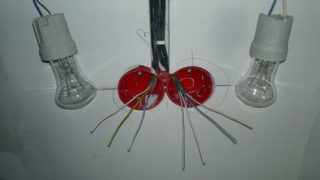
To figure out whether it is possible to lead an outlet from the switch, you need to have a good idea of the structure of the home electrical network. Understanding its design determines the possibility of making modifications.
The main scheme of the apartment electrical network
The path of the apartment wiring begins from the entrance panel, which is powered by a cable coming from the external house power grid. There is a panel device at the entrance of the house or at the front door of the apartment. Inside there is an automatic switch, to which power is supplied from the cable. In Soviet-built houses, in which the power grid has not been updated for a long time, circuit breakers perform the functions of an automatic device. The cables from the panel switch are directed to the electricity meter and then to each of the machines serving the group. Groups do not communicate with each other, and their number is determined by how many loads are in the apartment. They can be distinguished according to criteria such as ease of placement or the type of load used. A strict rule is the separation of appliances located in living quarters, and those in the kitchen and bathroom, according to different group bundles. From each of the machines, cables run into distribution boxes (one or more), to which the apartment light switches and socket outlets are connected. This design optimizes utility service and masks utility networks.
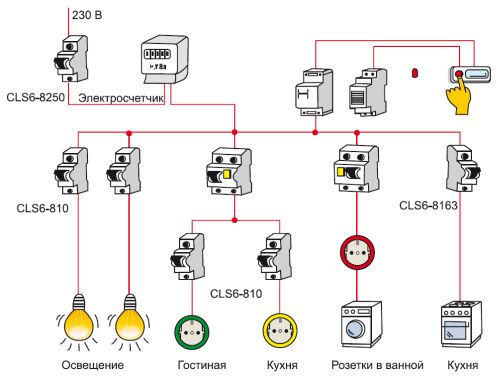
Connecting switches and sockets

To imagine how to properly connect the outlet to the switch or to the network, you need to remember the instructions from the Electrical Installation Rules. They find that the plugging process requires three cables with different functions. To simplify the visual determination of the functions of the wires, they should differ from each other in the color of the insulating material (in practice, electricians sometimes ignore this rule).
When connecting an outlet, use the following cables:
- Phase, the function of which is to power the serviced outlet, carrying an electric current to it. This is the only wire whose insulation color is not regulated by the rules: the main thing is that it differs from the colors of the other two cables.
- Neutral wire sheathed in blue or light blue. Like the phase, in the junction box it is connected to the power contacts of the socket.
- Grounding, the role of which is to protect residents from electric shock when touching the body of an electrical appliance, as well as to prevent short circuit situations. Its insulating material is yellow or green. The wiring is connected to the special contacts of the socket, reserved for grounding.
It is practiced to combine sockets with each other with parallel connection to the network or serial. In the first variant, each of the combined elements remains independent.
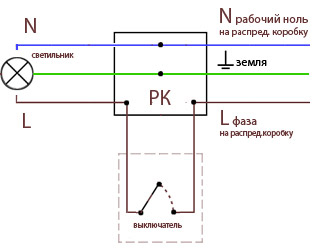
In the case of connecting the switch, only two cables are required, and both of them are phase. One is placed at the input of the connected device and connected to the phase of the group line. The other is led from the output of the light switch to the junction box and connected to the phase of the lighting device. The neutral wire of the latter must be brought into the box, bypassing the switch, to the supply cable.
Change the purpose of the electric point and connect one from the other
Knowing the peculiarities of connecting socket devices and lighting control boxes, you can replace one element with another or lay a connection between them. When performing any work on the connection, it is necessary to first de-energize this line, as well as the cables of adjacent lines, which can be accidentally touched.
Replacing the socket with a switch
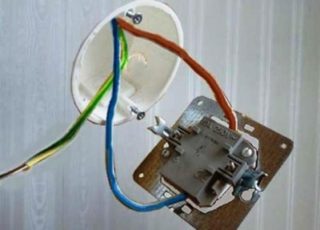
Of all the monitored operations, this is the simplest procedure. After removing the old socket, a trinity of cables remains - phase, zero and ground. It is necessary to identify each of the elements by the color of the protective winding. For reliability, you need to use a multimeter (it will be able to show the phase - the cable through which the current flows when connected to the probes of the device), since during installation work, the regulation of the colors of the wiring is sometimes ignored. In apartments of the old layout, where the modernization of the power grid has not been carried out, instead of three conductors, there will most likely be two (phase and zero), since grounding was almost never used before.
Having determined which wire performs which function, you need to connect the phase component to the input of the switch, and zero to the output. Then work is carried out in the junction box: the zero, which previously stretched to the socket housing, turns off and then connects to the phase of the luminaire. Grounding is not used in the operation, regardless of whether it was used in the old outlet or not. After that, the zero cable of the chandelier or sconce is connected to the network.
Replacing the switch with a socket
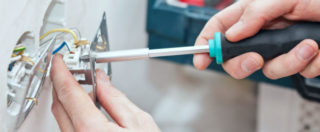
For the correct operation, additional cables must be laid. To connect the socket, three wires are required, and after removing the switch body, only a couple of them remain. But it is quite possible to connect an outlet box to this place, and the socket will work, but when using it, you will have to come to terms with some restrictions.
Refrigerators, electric kettles, heating devices cannot be connected to a power outlet without grounding. It should also be taken into account when choosing the rated current that thinner wires are usually used for luminaires than for socket structures.
First, switches are made at the site of the future localization of the socket box. To its power contacts, you need to connect the two wires left over from the switch. One of them will have to be transformed from phase to zero: in the junction box, turn off the cable that went to the phase wire of the luminaire before dismantling the lighting control device. It must be connected to the zero terminal of the supply cable of the group.
Connection from switch socket
This problem can be solved in two ways: by simultaneously connecting two devices to one wire, or by mounting the switch without manipulation in the junction box. Both options have advantages and limitations.
Connecting a switch from a socket without a junction box
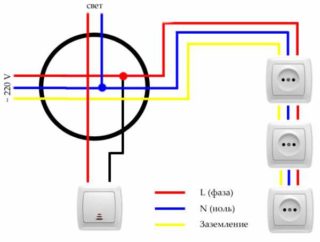
This scheme assumes that there are no additional twists between the distribution board, the chandelier and the switch. A wire is sent from the shield - two-core if there is no grounding and three-core if available. Before the lighting device, it must be led in one piece, and then a separation is made so that the zero remains there, and the phase goes to the switch. The phase from the switch button is brought to the contact of the chandelier up the wall, and then along the ceiling.
If the chandelier has many bulbs and there is an intention to connect it to a two-button switch, the shield wire is cut as described above, and a pair of wires from both buttons lead from the switch to the lamp. For this purpose, a cable with two cores is used. They are connected to the outgoing contacts of the switch (they will play the role of phases when the device is turned on) and direct the wire up to the chandelier. Again, the veins are divided into several centimeters and connected to the phase contacts of the chandelier.
This method of installation has a number of advantages - it minimizes malfunctions due to the ease of implementation and the absence of connecting additional conductors; it is available even to an inexperienced craftsman. The disadvantage of this type of connection is that when the cable is cut, there is no insulating material on the disconnected cores. To avoid this, single-core conductors with high-quality insulation can be used. Then one independent cable from the panel bus is directed to the contact of the chandelier, the other wire (phase) from the automatic switch is led to the light control device, and from the latter a cable is laid to the chandelier (from one or two cores - according to the number of buttons).
Connecting a switch and a socket from one wire
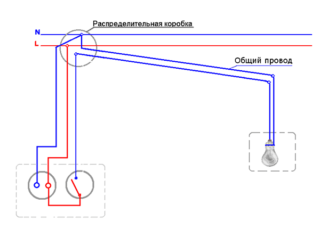
To install a box with one button, first connect the apartment board to the switchbox using a double (with phase and zero) wire. The luminaire is also connected to the distribution box with a two-core conductor. Then a trinity of wires from the paired switch and the socket are introduced into it, while a path must be laid from the phase terminal to the socket, and from the socket to the switch contact. The chandelier is connected to zero with one cable, the second with an unoccupied switch clip. If there is a grounding wire, it is connected in the junction box to the corresponding terminal.
To connect a two-button switch, five cables lead from the box to the block of two devices. The socket is set to zero and ground. A phase wire is fed to the switch by means of a jumper in the switching unit. The two remaining cables are placed on the free clamps of the switch. In the junction box, the conductors that guide the phase and those that go to the light bulbs are twisted.
Connection from the socket switch
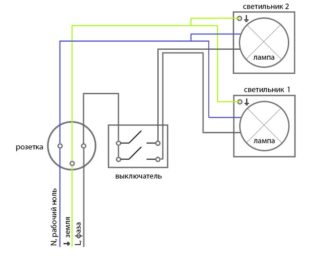
This scheme is the most difficult to implement. Although it is not so difficult to connect an outlet for temporary use, additional cable paths must be laid to ensure high-quality operation of both elements of the unit. Therefore, the described connection can be implemented only as a last resort.
Two cables from the switch box are connected to the power contacts of the socket. In this case, it is necessary to disconnect them from the switch so as not to create a short circuit situation. Since there is no grounding cable, one of the wires coming from the switch must be zeroed. This can be done in one of two ways:
- short-circuit the cables of the lighting fixture;
- turn off the cable coming from the push-button device in the junction box and connect it to the zero cable of the group.
Implementing a full-fledged connection between the outlet and the dimmer is very problematic. This operation requires the installation of conductors from the junction box to the outlet.
How to connect a lamp through a switch from the outlet

Use conductors with three or four conductors that perform different functions, and when separating, they are stripped of insulation by a few centimeters. Of course, the apartment must be de-energized beforehand. Wires and individual cores are connected according to a pre-designed scheme, making sure that they stretch in straight straight lines and do not form knots or interweaving. If the installation is carried out in a room whose walls are made of wood, it is necessary to lay paths in advance using plastic insulating plates. To lay the paths of the wiring hidden, you need grooves. Special channels are allocated for this option in reinforced concrete buildings.
When planning to replace the socket with a light control device or to connect them with each other, it is advisable to first evaluate the restrictions imposed by the procedure corresponding to a specific task. Having made the decision to carry out installation work, you can purchase the necessary device with the parameters suitable for the selected wiring diagram.









"The path of the apartment wiring begins with the entrance board, ..." - there is no such concept, there is a VU (input device), there is an ASU (input distribution device), there is a floor board (usually located on the staircase, or in a "pocket" - corridor).
“... In Soviet-built houses, in which the power grid has not been updated for a long time, the functions of an automatic device are performed by circuit breakers. … "- never switch switches were put instead of automatic machines, nonsense. The switch can only be in the ASU, located, as a rule, in the electrical room.
“Connecting the switch. In the case of connecting the switch, only two cables are required, and both of them are phase. One is placed at the input of the connected device and connected to the phase of the group line. … "- one cable comes to the switch - two cores: the" phase "came from the junction box and went to the luminaire.
I don't even want to read your delirium further, do not write about what you do not know, or you understand very little ...
“To be able to identify the functions of the wires in the niche” - is it poor in Russian? "Determine the purpose of the wires"? And what if instead of yellow-green, green and yellow, I have red and blue? What to do with black? how to be able to identify its function? Author! why did you ignore these questions?
Idiots read SNiP, PES and GOST. Since when does the yellow-green wire become a phase.
Roman, you wanted to say PUE (Electrical Installation Rules), and write yellow-green.
It is extremely rare for the zero switch to get to the switch, so the answer to the question in the title is - in no way.
Zero will have to be led from the branch box. But then it is better to take the phase from the same place.
it is impossible to put an outlet from one phase with a switch. will be bad.
Since when did yellow-green become zero, and the earth yellow or green !!!?
Phases A-yellow B-green C-red
Zero-N-blue
Earth-PE-yellow-green
In a three-wire system (220V), the phase must be different from N and PE
Everything is possible, but only low-power devices If the switch is one-key and the light is not needed - Insert a low-ampere fuse into the cartridge / the cat went before on the meters / And two keyboards will be both a set and a socket - one wire from the key will be removed from the cartridge with a fuse
The answer is simple. If there is, we do not touch the earth. In place of the switch, we put the socket, the phase should be there, we take zero by closing the wires going to the lamp, except for the ground. The second option is to find the junction box and switch the wires there, as it should be for the outlet.
NOT "blue", but - blue, if you follow the letter PUE